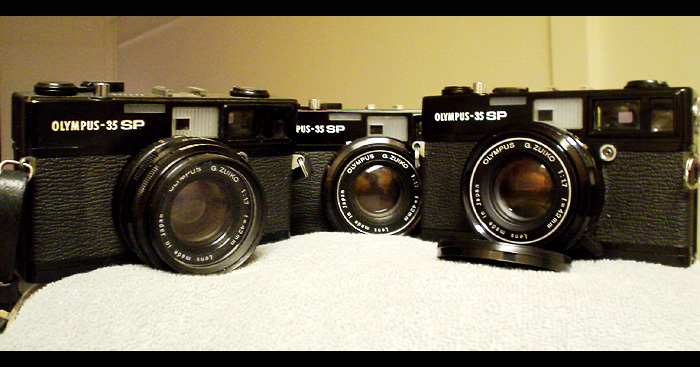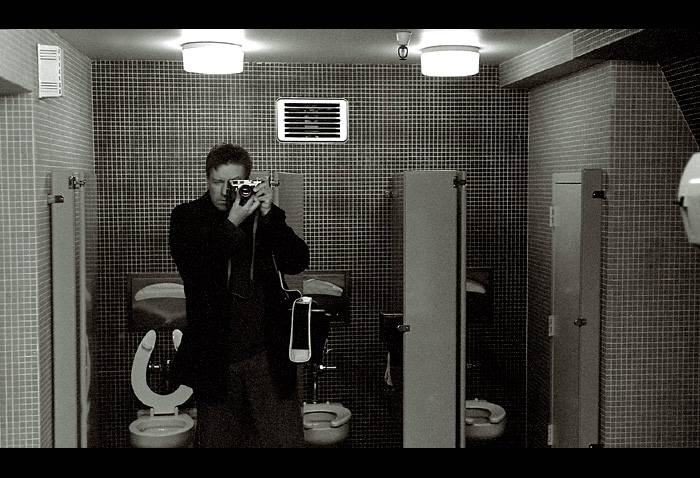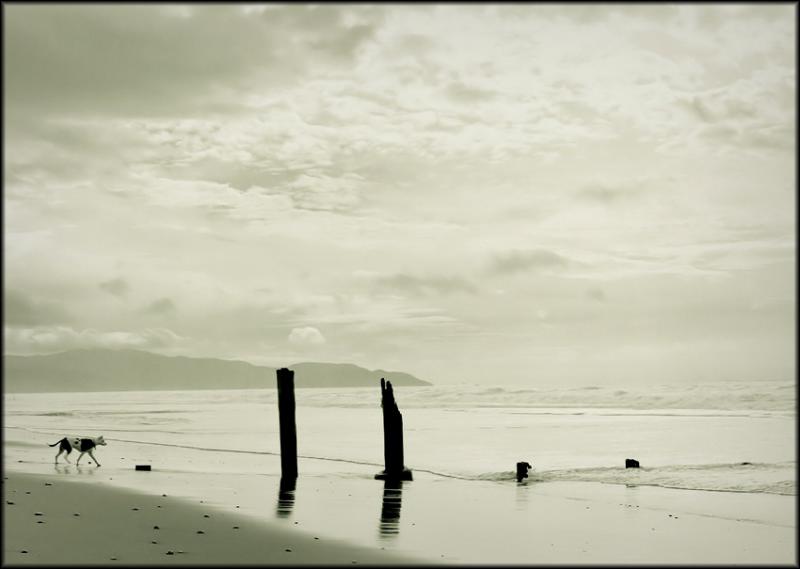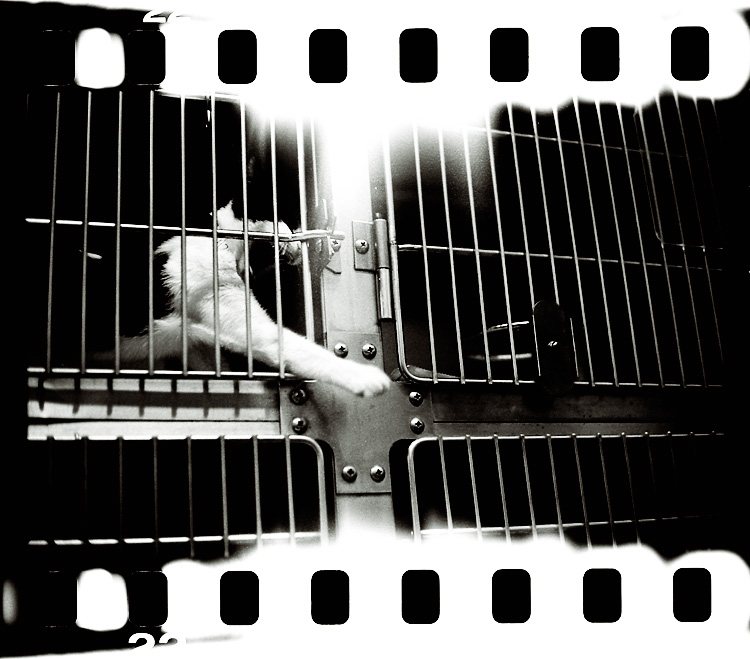Batteries Not Included
A blog focused on cameras with no batteries - and the photos they take
Note: This blog is optimized for use with Mozilla Firefox - the best, free internet browser there is
Note: This blog is optimized for use with Mozilla Firefox - the best, free internet browser there is
Thursday, October 20, 2005
Tuesday, October 18, 2005
Fixed Lens Rangefinders
There is something liberating in using a fixed-lens camera. It's normally a more compact kit and hence much easier to bring with you as a carry-around camera. By nature of being a fixed lens you therefore carry less stuff with you - no reason to bring that second or third lens with you. It also feel less 'complicated' and less of an undertaking to grab a camera with you as you head out the door.
When looking for a fixed-lens rangefinder camera one could do worse than looking into the ones that came out of Japan in the 60's and 70's. Companies like Canon, Olympus and Minolta produced some excellent cameras during that time that still today are excellent picture takers.
There are many advocates of the cameras that came out of former Soviet Union in the 40's through 70's but I'm not able to comment on them as I have yet to actually use one. For those interested in these cameras - and any other rangefinder camera for that matter - I recommend checking out the friendly forum at rangefinderforum.com.
Why should I even consider one of these cameras?
The way I see it there are three main reasons;
1) Price. These cameras does not necessarily have to cost you the farm,
2) Great optics. You will often find fast prime lenses that performs close to zoom lenses costing several hundred dollars.
3) Size. They are small and may even put some subjects at ease (as compared to using a modern, huge dSLR kit).
What Camera should I buy?
You'll get as many answers to that question as there are used cameras on the market. The good news here is that with the fairly low price on many of these cameras you have the oportunity to try a few of them out before settling on one that meets your requirements.
My personal short-list of cameras that would be worth looking into includes;
* Olympus 35SP/SPn
Estimated cost: $50-150
* Canonet QL 17 G-III
Estimated cost: $30-70
* Yashica GSN/GTN
Estimated cost: $10-30
It can't all be good can it?
There are indeed some 'sacrifices' you have to make if you decide to venture into the world of rangefinder-cameras-on-the-cheap.
1) The view- /rangefinder is often smaller and dimmer than those on more modern cameras - but they may be less cluttered as the viewfinder will only have to support framelines for one focal length.
2) The build quality is also often not up to par with what you may have have gotten used to from Canon, Leica or Nikon - but did I mention the price benefit? :)
3) As the name eludes to it's a fixed lens camera - meaning you're stuck with that one focal length.
I encourage you if you're interested to read up on the different models and characteristics (or quirks) that are out there. Odds are you'll end up with a small, compact camera with a fast, sharp lens for a price that won't make you think twice about bringing it with you out at night to the bar, to the beach or out on a drizzly, overcast day. It may end up living in your glove compartment - or in a pocket of your jacket - but it will have the power of being able to come with you anytime and anywhere and you may therefore be able to capture more of those fleeting moments that life is made up of.
How can that not be a good thing?

Olympus 35LE
 Olympus 35SP, black (yes, three of them...)
Olympus 35SP, black (yes, three of them...)Saturday, October 08, 2005
The photos I didn't take
As I sat at the bar and had my 'two eggs with bacon, toast and home fries' a number of scenes played out infront of me; there was the girl that slipped on the floor and sat down smiling as her friend helped her up and there were the mirrors on the opposite wall where people's faces were being reflected - nicely framed by the bottles and glasses at the bar.
I finished my eggs and left, walking down Polk Street here in San Francisco's Russian Hill neighbourhood.
It was a very sunny day and people were taking full advantage of it by dining outside of any cafe that could muster up any tables. Down an alley there were beautiful shadows spreading across the sun drenched walls and damn it if there wasn't even a small black cat sitting there enjoying the early afternoon sun. Quiet, nice scene. I walked on with the lens cap still firmly attached on the 'cron.
Came home. Tired and took a nap on the couch for a few hours. Woke up realizing that the day was slipping away from me and went up on the roof-top and the view out to the Golden Gate bridge was gorgeous in the afternoon light.
Later on took a short walk and the cable car came whizzing up Hyde Street with some tourists standing to the side taking a photo of it nicely sidelit by a late night open store.
I often have days like that. I carry a camera with me intending to capture moments with it - but more often than not I end up not taking a single frame. Honestly I don't mind. The point is not that I raised a camera to my eye and squeezed off the shutter but rather that I saw these images. The greatest gift that photography has given me has been that it has opened my eyes for 'seeing' scenes that I otherwise may have passed by.
It may not always enrichen my collection of contact sheets but I know that it enriches my life on a daily basis.
Thursday, October 06, 2005
Not to be a camera snob
These cameras are excellent picture taking machines but do I always need to carry a kit worth $1,000+ when taking a walk and snapping photos of whatever may present itself in front of my viewfinder? Of course not - but I am also honest enough to admit that I love the feel of a solid, well made piece of equipment and that enjoying the equipment I also tend to take it with me more often - and hence end up taking more photos. Call it...a joyous circle...
Now, I'm not a complete camera-brand snob...fact is most of my cameras cost under $50 each and I truly enjoyed using them - some of them I still take out for a spin now and then (more about 'Great cameras on the Cheap' coming up in an entry soon). One that really surprised me is the old Kodak Instamatic 500.
The production run of this camera was between 1963-1965 and it comes with a pretty decent Xenar 38/2.8 lens. Its main, modern quirkyness is that it used 126 film (producing square 28x28mm images) which is a bit harder to obtain and process than your regular 120/135 film but with some research I was able to find both film as well as places to have it developed here in San Francisco.
These cameras can often be had for less than $25 at eBay and I think I paid about $18 for this one.
Below are some sample photos from the first test roll I shot. It's a fun camera and very easy to use. Is it a Leica or Hasselblad? No, but if I drop it or lose it I will be very happy it wasn't..


(More information about the Kodak Instamatic product line here )
Wednesday, October 05, 2005
Mirror, mirror on the wall...
Mirror self-portraits are only second to Shadow self-portraits when it comes to being frowned upon as 'gosh, I can't believe you took one of those'-photos. That aside, mirror self-portraits does accomplish two very important things;
1) It gets your camera into the photo (and yes, many of us love the look of these cameras almost as much as we enjoy the photos they take...), and
2) It gets you into the photo. As the one always carrying a camera you will eventually realize that you are hardly ever in any photos yourself. This is an oportunity to make yourself the subject (well - second to the camera in some cases...).
So feed that narcissistic side of your personality, combine it with some pride in the equipment you've spent [way too much] money on and step infront of that mirror and join the ranks of others that have been there before and proudly declare "I am - a mirror self-portrait photographer!"
 Leica M3
Leica M3 Canon VT-deluxe
Canon VT-deluxe Olympus 35-LE
Olympus 35-LE
Monday, October 03, 2005
Fortunate Mishaps
Regardless of how an accidental element got into your creative process I feel it's important to not discard the final result simply because it was not what you had intended to capture. Look at the results with an open mind and who knows - you may be surprised as to what you find.
Below are a few examples of photos that did not come out at all as I had planned - through accidents..and mistakes.
 Hasselblad 500C/M, 80mm Zeiss lens, Tmax 400 film
Hasselblad 500C/M, 80mm Zeiss lens, Tmax 400 filmSaturday, October 01, 2005
Tools of the trade
This view has obvious merits in that composition, creativity and a 'good eye' will come through regardless of what camera is used.
The other, conflicting opinion, is that the tools used are as important as the eye behind them.
Examples you sometimes hear to support this view includes 'you can't use a 35mm camera for an image that will go on a billboard', 'you can't shoot a game of baseball with a manual focus camera', 'you can't do extensive macro-photography with a rangefinder camera', 'you can't do candid street photography with an 8x10 large format camera', etc, etc.
There are obvious good points in this view as well.
There are also people that enjoy the more technical aspects of photography and the tools used. They are often ridiculed by people that are of the tools-does-not-matter group and referred to as 'fondlers' - especially if they also collect photographic equipment.
One of the more entertaining forums, where people from all these groups 'collide' is photo.net's Leica Forum.
Me, I'm a camera-collecting-fondling-user-believing-that-both-vision-and-the-tools-make-a-difference
I guess it means that I take no sides - and all sides. I should run for politics.
Having said all that, here are some of my current, favorite 'tools'...:
Leica M3
This fine piece of fine German machinery is from 1964 and the fondler side of me enjoyed building a small kit with a contemporary 50/2 Summicron lens and hood (featured in the photo below), an MR-4 meter and a very nice half-case from Luigi's.
The user in me is enjoying carrying around and using this camera as my current favorite camera.

Canon VT-deluxe
This gorgeous Canon body is from the late 50's and features a built-in trigger-winder in the bottom plate. Using it is somewhat of an acquired taste and personally I really like it.
The viewfinder on this camera is currently very dim and it's about to be sent out for cleaning and possible re-silver the viewfinder mirror. Maintenance is definitely one aspect of owning and using these older camera bodies - but it's worth it.
Body below equipped with a Canon 50/1.4 lens and an S-50 hood.

Hasselblad 500C/M
It's a brick from the land of SAAB, Volvo, IKEA, ABBA and tall blondes - the camera that went to the moon: The Hasselblad.
This camera represents to me the essence of camera-zen. It forces me to slow down and use a tripod and it's modular design is as genius as it is simple - and the large, square images it produces has more detail than I could ever hope to get out of any 35mm film - regardless of the glass used.
Coupled with some Zeiss glass this kit becomes an almost unbeatable manual, medium format camera in both portability and quality. With second hand prices dropping the way they are this classic camera kit is now within reasonable reach for many hobbyists. God bless digital sometimes :)
[Image to come]
First Entry
I spend a tremendous amount of my life in front of a computer screen and wherever I turn or whatever I do these days there seems to be a significant amount of electronics, automation and other modernifications.
Now, I'm not Amish - and most of the time I enjoy and depend on this level of modern comfort - but photography has for me become an outlet for a creative side of me where I choose to try to keep my tools as basic and manual as possible without giving up on quality and easy of use.
Photos posted on this site will all be made by manual film cameras (35mm or medium format) without any commercial intent.
It is my intent to present photos here and to address both the technical aspects of it - as well as my thoughts and feelings at the time the photo was taken.
Welcome.
/Rich Silfver

